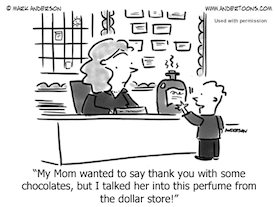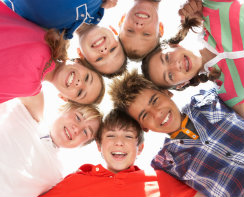Humor in the Classroom
 Let’s have a multiple choice beginning.
Let’s have a multiple choice beginning.
Humor in the classroom is good because:
1) Humor builds community.
2) Brain scans show students learn better with humor in the mix.
3) Kids say the funniest things.
4) All of the above. [Hint: pick me! pick me!]
Whether you view humor in the classroom as a well-earned option or a utilitarian strategy to infuse young brains with learning (or somewhere in between), seeing students smile or laugh with a spark of comprehension can make a teacher’s day. After all, as educator Joel Goodman notes, “Humor and creativity are intimately related — there is a connection between HAHA and AHA.”
 Why Humor Works
Why Humor Works
When it comes to giggles, science is on your side. In an NEA video three practitioners discuss why humor works and share their own experiences putting it into play. One of the participants, educator Mary Kay Morrison, author of Using Humor to Maximize Living: Connecting With Humor, hosts the website Humor Quest where she shares some of the resources from her presentations. For an overview of her take on humor research and strategies, read her post at TeachingShop.com, “Taking Humor Seriously.” Morrison even tackles incorporating humor into the often humor-free zone of standardized testing.
Writing for Edutopia, Mark Phillips considers ‘What’s So Funny About Teaching.’ After he suggests that educators without senses of humor find a different occupation, Phillips explains the difference between simply telling jokes effectively and expressing a sense of humor. He recommends the latter for the long term, noting “What I mean by a sense of humor is an ability to see absurdity in the class, school meetings and in oneself, and an ability to laugh at it.” (At Edutopia, also see Using Humor in the Classroom.)
For an overview of several classroom humor issues, turn to “Make Me Laugh,” a 2001 article from ASCD’s Education Update newsletter. It seems to have misplaced its author, but if you have time for just one well developed, mostly K12 article, this one (with tips!) tops the list.
What Works and What Doesn’t
Why use humor in the classroom? Speaking at a 2007 conference about ideas from his book Humor as an Instructional Defibrillator, Professor Emeritus Ronald A. Berk explains humor provided through speech, video, music and games in the classroom. He touches on the research into humor’s effects on learning, what humor to avoid, incongruity as the essence of humor, and low and high risk strategies. Along the way Prof. Berk provides lots of examples of humor for his professor-packed audience. Middle grades educators can adapt his ideas (and those of other higher ed humor experts) to their age groups and get some laughs along the way.
Among psychologist Steve Wilson’s 48 Classroom Action Projects about Humor & Laughter you are likely to find many to engage your students. Wilson, President and Founder of the World Laughter Tour, touches on many aspects of humor – including keeping it kind – in his collection of articles.
Cartoons for Class
Cartoons catch ideas, often very funny ones, in one image. Mark Anderson draws for companies around the country, but he saves some right-on ideas for the classroom. Being married to a teacher helps keep him attuned to education realities. Don’t miss his school collection at his website. Anderson is happy (he told us so) for teachers to use his cartoons in lessons and classroom displays. He also sells subscriptions to schools and districts for newsletters, websites and such. Students who enjoy cartooning may want to visit Anderson’s blog, especially the post that shows step-by-step creation of assorted creatures.
For political cartoons you can visit Daryl Cagle’s The Cagle Post Cartoons and Commentary. Under Fair Use teachers and students can make limited use of the thousands of cartoons by the many artists on the site. To share, print or make other uses of a cartoon, teachers can become ‘heroes.’ The site is searchable by key word and topic and is updated endlessly. Great for social studies, critical thinking skills, art.
Sidney Harris (aka S. Harris) has been drawing math, science and tech cartoons for well over fifty years. Who can forget the blackboard-filling equation with “then a miracle occurs” inserted halfway? His website, Science Cartoons Plus, is crowded with choices. A few of the ed drawings are for youngsters. Browse other categories for just the right topic and email a request to use in the classroom. Prints start at $60.
 Videos for Learning and Laughing
Videos for Learning and Laughing
Videos can bring humor into the classroom. In this Teaching Channel video, teacher Marlo Warburton creates a math song and explains how silliness works to reinforce basic information. Students can see parody in action in Amy Erin Borovoy’s ‘Five-Minute Film Festival: Best Education Parodies of 2012.’ Be sure to preview for appropriateness. Lady Gaga’s Bad Romance spun into a women’s suffrage review is a bit much for younger students. (Find Keyana Stevens‘ 2015 parody festival here.)
More for the teacher than the student, Doni Tamblyn usually brings humor into the corporate workplace through her company HumorRules. In this video the former comedian suggests adding a fun thing to every day, recounting how her work designing a humorous traffic school drew her into humor research and spreading the word on sharing humor in the workplace. Tamblyn is the author of Laugh and Learn: 95 Ways to Use Humor for More Effective Teaching and Training.
ELA Fun
Let students try their hands at writing humorously with this writing workshop from Scholastic for grades 6-12. It includes ideas for publishing. Middle schoolers can respond to ‘Jabberwocky’ in a Read Write Think lesson by creating their own nonsense poems – and learn a few parts of speech along the way.

To keep up with the best in funny children’s books, look over the selection from the Roald Dahl Funny Prize announced 2008-2013. Plans are for the Funny Prize to return in 2016 as part of the celebration of Dahl’s centenary. Recently funny are 2012’s Dark Lord: Teenage Years, The Dragonsitter, Socks Are Not Enough, Gangsta Granny, Chitty Chitty Bang Bang Flies Again and Goblins. The ALA’s YALSA reviews YA humor is this blog post and provides a quick overview of the genre here.
Get students into the act themselves with an extended unit on stand-up comedy. In her MiddleWeb guest article Ha! Ha! Building Serious Skills Using Stand-Up Comedy, educator/author Sue Stephenson outlines the research and writing seventh graders experienced on their way to developing stand-up routines. A wonderful time was had by all!
What’s So Funny about the State Department of Education?
We found several state department of education websites with humor resource pages. We’re guessing they support various standards that address humor. Here’s a good example in West Virginia, sharing riddles, jokes and puns. One link leads to “Puns for Middle School Teachers,” a page put together by Louisiana’s Vermilion Parish Schools. Though several of the links are dead, be sure to check out their Powerpoints for teaching puns, tom swifties and more. The PPTs include some kid-created puns that might inspire your own students to give comedy writing a try.
Mathematically Amusing
Math and science teachers can introduce students to What If?, the website that takes questions submitted by readers and then uses math, physics and fun to provide simple drawings and extreme conclusions. Recent questions consider how many model rocket engines it would take to launch a real rocket and what impact a huge diamond meteor would have on hitting Earth, submitted by an eight year old. Many discussions involve explosions. Are we surprised? The author, Randal Munroe, also writes the webcomic xkcd.com — not all of which is suitable for youngsters and liberal arts majors, or so he says.
The NY Museum of Math website has a page filled with paper puzzles, fun if not exactly funny. MOMATH also features three dimensional puzzles at its MathMONDAY Maker page. For laugh-out-loud fun teen students may enjoy the Math Education section of this site at the University of Utah. Math teachers will likely laugh at the other nine sections.
After offering a long list of strategies for infusing humor into the classroom, Rutgers professor Maurice Elias concludes, in an Edutopia blog post mentioned above, “Let’s add some more enjoyment to school. We don’t need guffaws — a smile and a little levity can go a long way. It’s time for us educators to take humor more seriously.”
For more classroom fun and learning, visit Laura Davis’s Edutopia post, Creating a Classroom Culture of Laughter and Ron Nash’s CorwinConnect article, Laugh and the Kids Laugh with You.




































I was so happy to read this blog. I can’t believe there are still teachers who follow that old adage: don’t let them see you smile until January. Honestly, I love a good laugh. It just feels good. I truly believe that one reason why I don’t have some of the issues with many of the “behavior problem” students is that I try to bring a sense of humor into my classroom. More often than not, my students feel comfortable around me, and believe that I care about them. I definitely think it’s my humor that accounts for it. That is not to say that I don’t believe in being serious or that I don’t take my job seriously. One of the first things I talk to my students about is responsibility and how important my work is to me.
Thank you so much for including so many excellent resources for incorporating humor into the classroom. I hope many teachers read this and take your advice. I think humor is an easy way to engage students in learning. After all, if you don’t like something, you are less likely to care about it. Sometimes I think teachers forget that.